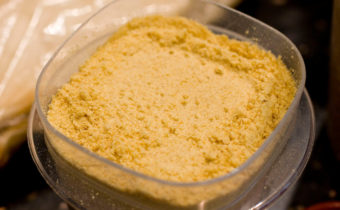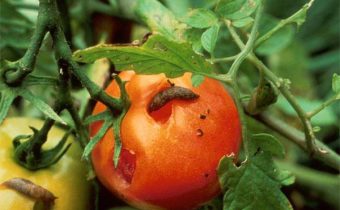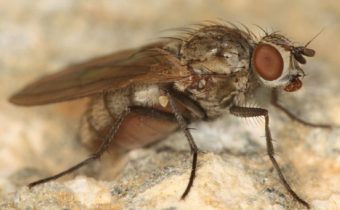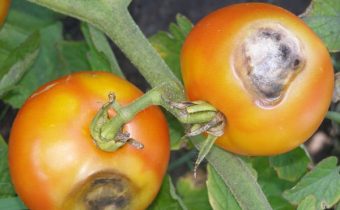White leaf leaf tomato, treatment methods for septoria
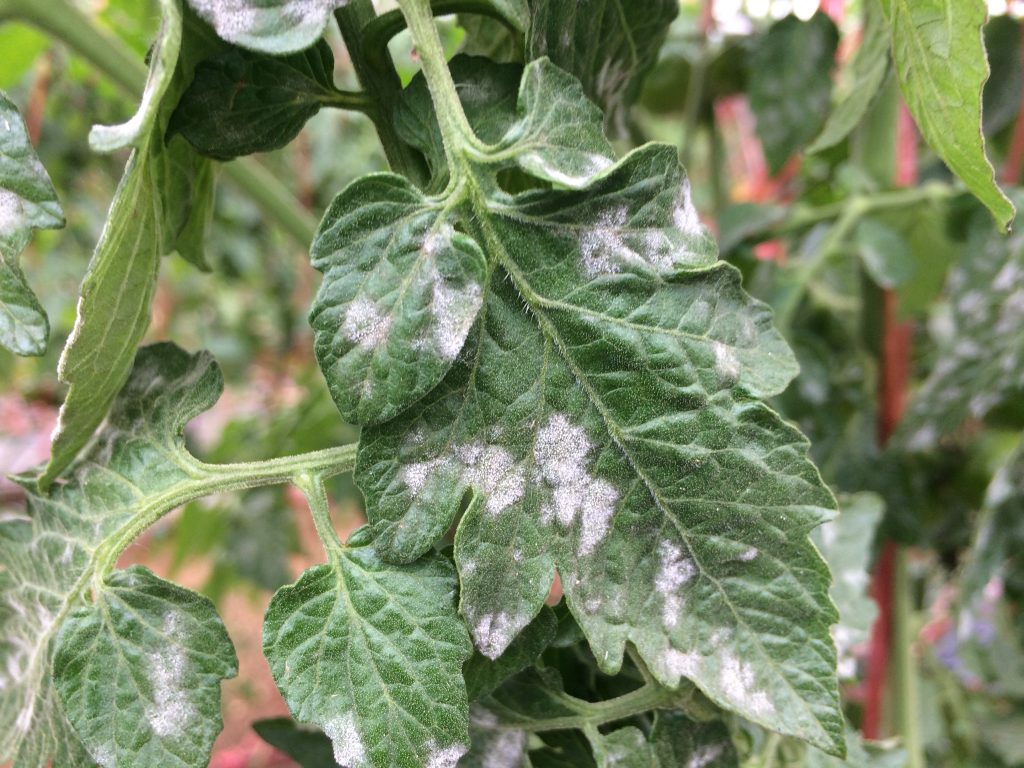
In open beds and in greenhouses, tomatoes are affected by a fungal infection, called white spot. Without taking timely treatment measures, you can get a yield loss of 30 to 50%.
Biology of the pathogen Septoria
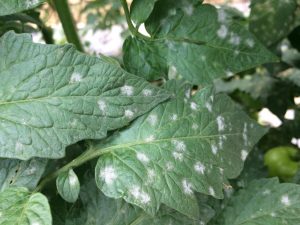 White spot or septoria causes the fungus Septoria lycopersici Speg. The pathogen belongs to the group of deuteromycetes, on the surface of the leaves of tomatoes forms asexual sporulation, pycnidia. The fruiting bodies of the fungus are black, have a wide opening for the release of conidia. Pycnospores are colorless, spread by air and by droplets, are also spread over plants by insects, on clothing, through agricultural implements.
White spot or septoria causes the fungus Septoria lycopersici Speg. The pathogen belongs to the group of deuteromycetes, on the surface of the leaves of tomatoes forms asexual sporulation, pycnidia. The fruiting bodies of the fungus are black, have a wide opening for the release of conidia. Pycnospores are colorless, spread by air and by droplets, are also spread over plants by insects, on clothing, through agricultural implements.
The pathogen develops under the condition of high humidity (from 77 to 100%), with temperature indicators from + 20ºC to + 25ºC. Conidia ripen in pycnidae and, under favorable conditions, are pushed through holes. The incubation period is from one to two weeks.
Septoriosis often affects tomatoes growing in beds under the open sky.
At the first symptoms of white spotting, it is required to begin treatment, since spores at moderate temperature and high humidity spread quickly, affecting not only tomatoes, but also other cultures. Eggplant, potato, and flower cultures such as peonies, chrysanthemums, and phloxes are susceptible to septoriosa. Of cereal plants, the infection poses a serious danger to wheat.
Causes of the disease
The time of infection is different, but the most dangerous is the manifestation of the disease in early summer. Without prompt treatment measures, the loss of fruit harvesting is up to 35-40%.
The fungus Septoria lycopersici Speg appears when the weather is wet, so gardeners need to be especially careful during warm and rainy summer.
In the beds, tomatoes are sick more often, in the greenhouses there are local foci. Among the causes of the disease:
- waterlogging;
- non-compliance with the rules of agricultural engineering;
- lack of regular disinfection.
The pathogen is preserved on residues of plant debris (tops), is carried by some weeds.
Symptoms of septoria
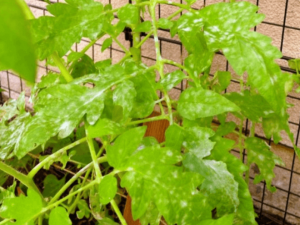 The first affected lower leaves of tomatoes, which are closer to the soil surface. The infection manifests whitish spots on the surface of the leaves of plants.
The first affected lower leaves of tomatoes, which are closer to the soil surface. The infection manifests whitish spots on the surface of the leaves of plants.
At first, the spots are light, small in size, but as the infection progresses they grow and change color. A black stripe appears around the border, and the central part of the spot is covered with a gray patina of pycnidia. Gradually spots appear on the stalks of tomatoes, petioles.
Tomatoes, stems, petioles become brown in color, curl, dry out and die. In plants damaged by the fungus Septoria lycopersici Speg, development slows down, as it takes energy and food to form new leaves. With the defeat of tomatoes in early periods, the flowering dates are postponed, fewer fruits are produced, and with a strong infection the plants die.
On ridges, the area of infection can be large, in greenhouses, greenhouses and tunnels - local lesions (individual bushes).
Septoria is manifested on the leaves of plants, less often the infection seizes stems and fruits. If white spotting is manifested on the fruit, the plant is removed from the ridge, the tops, along with the roots and fruits are destroyed. Infected tomatoes can not be eaten.
Measures to combat the disease on tomatoes
In order to prevent the occurrence of septoria at the site, first of all, compliance with the basic agrotechnical methods is required.
- Tomatoes on ridges are recommended to be mulched using peat, humus, mowed grass. Mulch helps to regulate the soil moisture level, preventing overmoistening.
- Observance of distances between plants when planting. When thickened, ideal conditions are created for the development of the fungus.
- After watering, the soil must be loosened, providing access to oxygen and preventing the formation of a hard crust.
- In the garden, in the greenhouse, the plants are tied up, preventing the bushes from falling to the ground. When wet weather spores of fungi from the soil fall on the leaves and begin to multiply rapidly.
- When a damaged shrub is found, it is isolated from others, with a small amount of damage, diseased leaves are carefully removed and sprayed with a fungicide.
- With a high degree of damage, a tomato is dug up and destroyed. Landings with the preventive purpose sprayed with chemical preparation.
Tomatoes from plants that have been treated with a fungicide are allowed to be eaten no earlier than in 21-25 days.
Biological means of treatment of septoriosis tomatoes
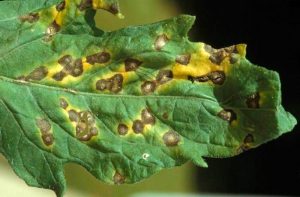 In this group are presented drugs that act on infectious agents. They are based on strains or bacteria of antagonistic fungi that inhibit the growth of pathogenic microflora, but at the same time harmless to humans.
In this group are presented drugs that act on infectious agents. They are based on strains or bacteria of antagonistic fungi that inhibit the growth of pathogenic microflora, but at the same time harmless to humans.
Planriz
The basis of the bacteria are Pseudomonas fluorescens. The drug is effective against white spot, bacterioses, stem and root rot.
Used for seed treatment, as a preventive treatment. Apply according to the instructions, a 0.5% solution is prepared for tomatoes, sprayed every 12-14 days.
Fitosporin M
The agent is based on the bacterium Bacillus subtilis 26D, hay bacillus, aerobic. The drug is a systemic fungicide that inhibits the growth of pathogenic microorganisms, enhances immunity.
Used for soaking seeds, processing plants (spraying), soil.
Alirin b
The active ingredient is the bacterium Bacillus subtilis VIZR-10. Biological fungicide produced in powder form, tablets.
On tomatoes used in the composition of the solution for spraying, for irrigation.
It is recommended to add soap (chips, liquid product) to the solution for better adhesion to the leaves.
Chemical treatments for septoriosa tomatoes
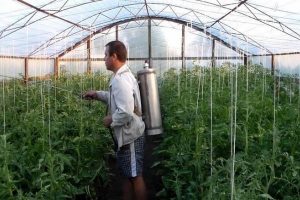 In case of serious damage to landings, chemical preparations are required. The following remedies are effective from fungicides:
In case of serious damage to landings, chemical preparations are required. The following remedies are effective from fungicides:
Fundazole
Diluted in water, proportion: 5 g per 5 liters of water. This drug is poorly soluble, so it is recommended to first take a small amount of water, stir in it, and then add to the required volume.
Revus
Used for spraying, on a bush - 20-40 ml of composition. The solution is prepared by mixing 10 ml of Revus in a bucket of water (10 liters).
Ordan
The drug is used at the initial stage of the disease, when the spots on the leaves are small. Dilute the solution: 25 g of the drug is taken for five liters of water. Such a volume is sufficient for spraying weed plantings of tomatoes.
Thanos
Likewise, tomatoes are treated with Tanos, pre-diluting it (6 g) in a bucket of water. The tool is fast, the protection period is up to two weeks.
Bordeaux
Used from fungal infections, sprayed tomatoes before flowering. Solution: per liter of water take 1 g of the drug.
Hom
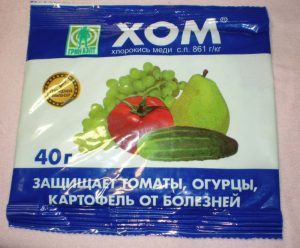 The basis of the means - copper oxychloride, destroying the cells of infectious agents. The drug is used as a prophylactic agent, as well as in the early stages of the disease. The elements of the drug do not penetrate into the tissues; a protective film is formed only on the surface.The pathogen does not get used to Homa, which allows the use of the tool repeatedly. Sprayed every 10-12 days. Solution: 40 g of the preparation are added to a bucket of water.
The basis of the means - copper oxychloride, destroying the cells of infectious agents. The drug is used as a prophylactic agent, as well as in the early stages of the disease. The elements of the drug do not penetrate into the tissues; a protective film is formed only on the surface.The pathogen does not get used to Homa, which allows the use of the tool repeatedly. Sprayed every 10-12 days. Solution: 40 g of the preparation are added to a bucket of water.
Kuproksat
The drug is based on copper sulfate. In a liter diluted with 5 ml of funds, sprayed tomatoes every other week.
The use of copper-containing drugs is indicated both for the prevention of fungal infections, and in the early stages. In addition to the means of Hom and Kuproksat use Bordeaux liquid, the drug Abiga-peak.
Measures for the prevention of septorioz on tomatoes
Thanks to carrying out simple procedures, it is possible to secure landings from an infection.
- Compliance with crop rotation on the site.
- Timely removal of plant residues.
- Planting varieties and hybrids, resistant to white spot (Horiv, Golden Fleece, Beryl F1 and others).
- Regular inspections of plants for the purpose of early detection of the disease.
- Correct watering (by volume, frequency).
- Acquisition of healthy tomato seedlings.
- Mandatory pre-sowing treatment of seed material (disinfection, hardening).
Creating optimal conditions for the growth of tomatoes, care and proper care, prevention of diseases - all this together will allow to collect a good crop of vegetables on the site.


